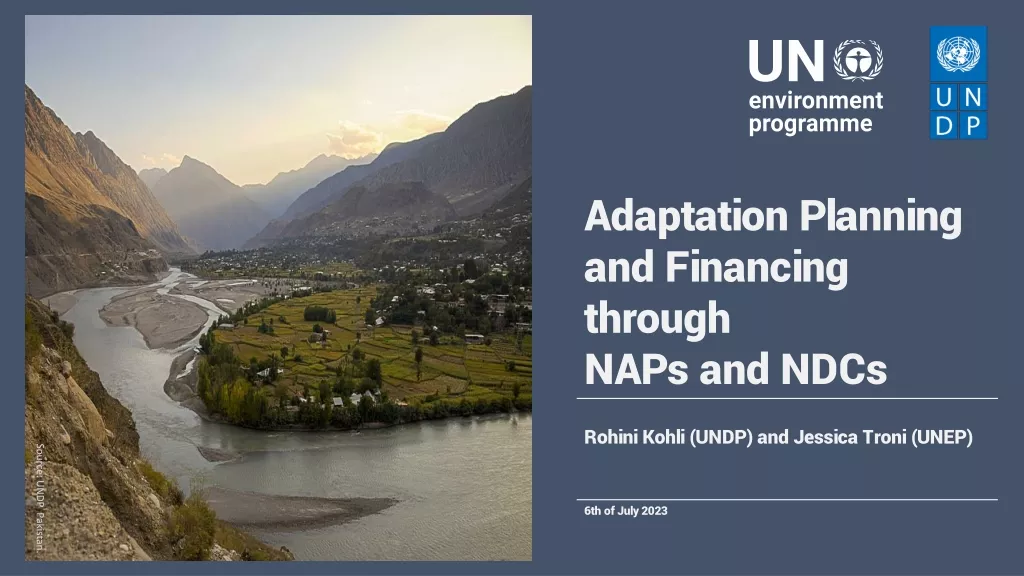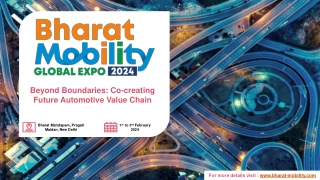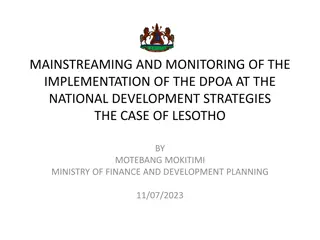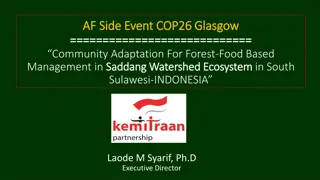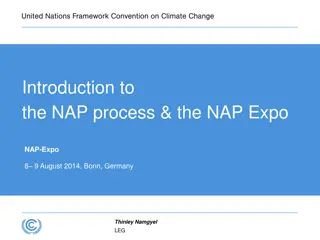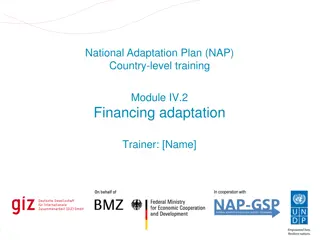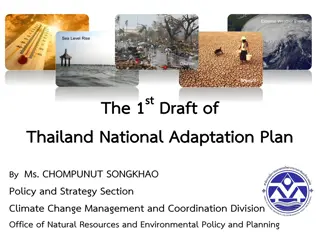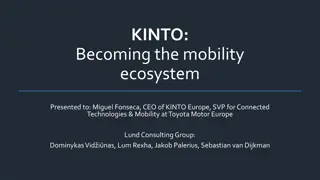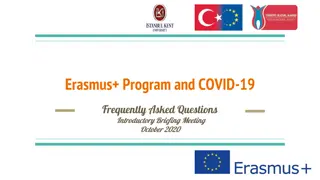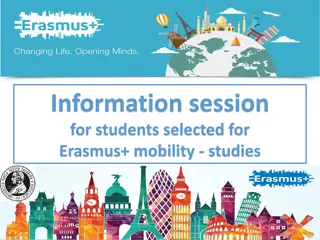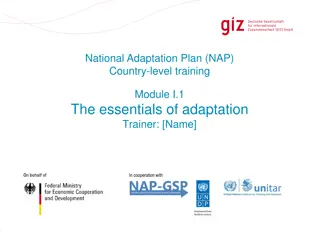Mainstreaming Human Mobility in National Adaptation Plans for Climate Resilience
Addressing human mobility-related challenges and opportunities in the context of climate change is crucial for avert, minimize, and address climate-induced displacement and involuntary mobility. This supplement provides a step-by-step guide to mainstream human mobility into National Adaptation Plans (NAPs), emphasizing a rights-based approach and the inclusion of vulnerable populations. It includes tools for establishing institutional arrangements, stocktaking existing knowledge, capacity building, and formulating NAPs based on evidence and knowledge.
Download Presentation

Please find below an Image/Link to download the presentation.
The content on the website is provided AS IS for your information and personal use only. It may not be sold, licensed, or shared on other websites without obtaining consent from the author.If you encounter any issues during the download, it is possible that the publisher has removed the file from their server.
You are allowed to download the files provided on this website for personal or commercial use, subject to the condition that they are used lawfully. All files are the property of their respective owners.
The content on the website is provided AS IS for your information and personal use only. It may not be sold, licensed, or shared on other websites without obtaining consent from the author.
E N D
Presentation Transcript
Addressing Human Mobility-Related Challenges and Opportunities in the Context of Climate Change: A Supplement to the UNFCCC Technical Guidelines for the National Adaptation Plan Process Building Capacities to Mainstream Human Mobility in National Adaptation Plans Dubai, UAE 10 December 2023 Harald STERLY University of Vienna, Department of Geography and Regional Research
Starting point: Why should human mobility be mainstreamed in National Adaptation Plans? Adaptation helps to avert, minimize and address climate induced displacement and involuntary mobility. Certain types of human mobility (e.g., planned evacuation, planned relocation, labor migration, etc.) can contribute to adaptation. Refugees, internally displaced persons, and migrants in transit are among the most vulnerable to climate risks.
How does it work? What is the Supplement? Inclusion of a broad range of human mobility types. Step-by-step guide to mainstream human mobility into the NAP formulation process. Mainstream human mobility in all stages of the NAP formulation process. Concise, operational, and user-friendly information and tools. Designed for stakeholders interested and active in mainstreaming human mobility into the adaptation planning. Include relevant stakeholders, and consider diversity of needs and perspectives. Based on the experiences of main- streaming human mobility into the NAPs of Ecuador, Republic of Moldova, Tajikistan, the Republic of Marshall Islands, Turkmenistan, and Uzbekistan. Focus on a rights-based approach, and those who are most vulnerable.
How does the supplement look? The supplement has four parts: 1. Introduction (rationale) 2. Background (human mobility types) 3. National Adaptation Plans (NAP process) 4. Key steps for mainstreaming migration into NAPs (step-by-step tools) 4.1 The national coordination, steering mechanism, and institutional arrangement Parts of NAP Process ( Outcomes GCF Readiness Proposals // Elements of the UNFCCC Guidelines 4.2 Evidence and knowledge base 4.3 NAP implementation strategy 4.4 Reporting, monitoring and evaluation
4.1 National coordination, steering mechanism, and institutional arrangement are established 4.1.1 Establishing Institutions and coordinating bodies Tools: Stakeholder lists, and template for initial and bilateral briefings. 4.1.2 Stocktaking: Systematize existing knowledge and gaps Tools: Checklists for stocktaking of human mobility and adaptation issues; for situation analysis; and materials for policy mapping. 4.1.3 Capacity building of coordinating bodies Tools: Materials for capacity building workshops.
4.2 Evidence and knowledge base created, NAP formulated 4.2.1 Evidence base: Systematize climate risks & impacts Tools: Checklists for mainstreaming human mobility into mapping of risks, vulnerability and adaptation; principles and examples for case studies. 4.2.2 Evidence base: Review adaptation options Tool for operationalizing adaptation. 4.2.3 Compile and communicate the NAP Tools: Checklists and steps to include human mobility in drafting and reviewing the NAP document; and examples from the NAP documents in different countries. 4.2.4 Sectoral mainstreaming Tools: Steps for sectoral briefings and stakeholder inclusion; checklists for including human mobility in key sectors.
4.3 NAP implementation strategy developed 4.3.1 Capacity building of implementing bodies Tools: Materials for training workshops. 4.3.2 Developing local adaptation plans Tools for local stakeholder inclusion, awareness raising, drafting local plans, and capacity development. 4.3.3 Synergies at the regional level Tools: Materials for briefing regional actors, and for promoting coordination and synergy in the context of different global policy frameworks.
4.4 Mechanisms for Reporting, Monitoring and Reviewing of NAPs 4.4.1 M&E: Indicators and Reporting Strategies Tools: Materials for including human mobility stakeholders in formulating indicators and reporting; for including human mobility stakeholders in working groups. 4.4.2 M&E: Climate budget tagging (CBT) Tools: Guidance for including human mobility stakeholders and considering migrants in designing CBT. 4.4.3 M&E: NAP is iteratively updated Tools: Guidance for human mobility stakeholder inclusion. 4.4.4 Publish NAP and Outreach Tools: Material for human mobility stakeholder inclusion, consultations, curricula, and outreach.
Wrapping it up a human mobility supplement on the NAP Practical and hands-on collection of tools. Considers a broad range of human mobility types. Mainstreaming of human mobility in all stages of the NAP formulation process. Inclusion of relevant stakeholders on all levels, emphasizing the local, and the diversity of needs. Focus on a rights-based approach, and on those who are most vulnerable.
Thank you for your attention Harald Sterly University of Vienna harald.sterly@univie.ac.at Potatofields in Mae Chaem District, Thailand (picture: Harald Sterly, 2020)
Tour de Table Sharing the experiences of roundtable participants
Guiding Questions Youth Mainstreamed human mobility Introduce yourself (name, designation, institutional affiliation, and country). Did your country mainstream human mobility in the NAP formulation? Why was it necessary to mainstream human mobility in the NAP formulation in your country? What were three key lessons learned from this mainstreaming process that would be valuable to other roundtable participants? Based on your experience, what are/ were two key capacity- building needs related to mainstreaming human mobility into the NAPs in your country? Introduce yourself (name, designation, institutional affiliation, and country). What were the main adaptation- related outcomes from the COY? How does the youth envisage participating in the NAP formulation and implementation? From the youth perspective, what are three key capacity-building needs related to mainstreaming human mobility into the NAPs? Introduce yourself (name, designation, institutional affiliation, and country). Is your country planning to mainstream human mobility in the NAP formulation? Why is it necessary to mainstream human mobility in the NAP formulation in your country? Based on your experience, what are three key capacity-building needs related to mainstreaming human mobility into the NAPs in your country? Would like to mainstream human mobility
Slido Questions We will answer a few questions using Slido. Participants can join at Slido.com with code #2150139 or scan the QR code.
Please name the country you represent? Start presenting to display the poll results on this slide.
Which department is responsible for NAP formulation in your country? Start presenting to display the poll results on this slide.
What do you see as the main challenge to integrate human mobility in NAP formulation and implementation in your country? Start presenting to display the poll results on this slide.
In which areas are capacity-building activities needed for mainstreaming human mobility into the NAP process in the short- and medium-term? Start presenting to display the poll results on this slide.
Any additonal feedback? Start presenting to display the poll results on this slide.


